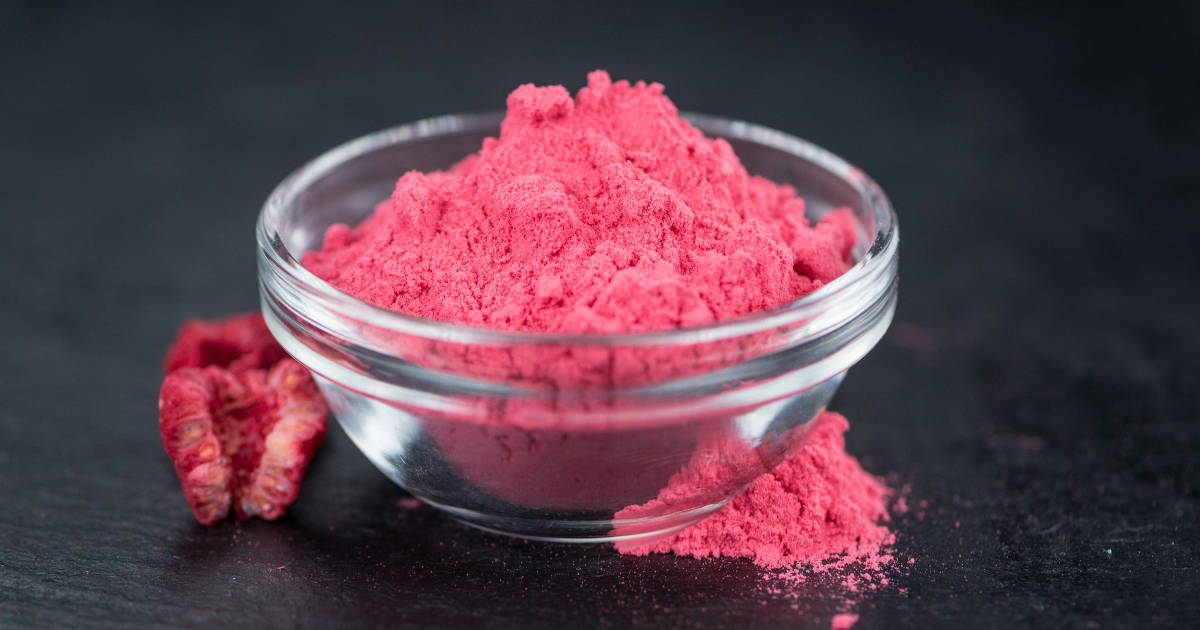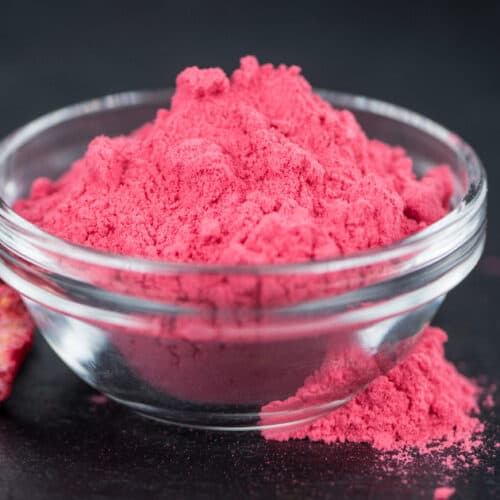Raspberry powder is a versatile ingredient that can be used to add bright flavor and natural color to baked goods, drinks, yogurt, cereals, and more.

Making your own raspberry powder at home is easy if you start with fresh or frozen raspberries.
Choosing Raspberries for Powder
The first step in making raspberry powder is selecting high-quality fresh or frozen raspberries.
When buying fresh raspberries, look for plump, firm berries with a deep red color. Avoid mushy or moldy berries, as these will not dehydrate well. Raspberries sold in containers are often freshest.
If using frozen raspberries, select unsweetened whole berries. Let them thaw completely at room temperature before dehydrating. Frozen berries work well but may take longer to fully dehydrate.
No matter which type you use, sort through the berries and remove any that are crushed or appear overripe. This ensures you end up with a high-quality powder.
Washing and Preparing Berries
Rinse fresh raspberries gently under cool running water. Use a colander to drain, then gently pat dry using paper towels. There’s no need to remove stems or leaves prior to dehydrating.
If using fresh, unsprayed berries from your garden you can skip rinsing. But for store-bought berries, washing helps remove dirt, debris, and pesticide residues.
After washing, spread rinsed berries in a single layer on towels or paper towels to absorb excess moisture. The drier they are before going into the dehydrator, the faster the drying process will be.
You can also use a salad spinner to gently spin berries after rinsing to remove even more water. Just don’t crush the delicate berries in the process.
Some people recommend spraying berries lightly with lemon juice before dehydrating to prevent browning. This step is optional but can help preserve color.
How to Dehydrate Raspberries
A food dehydrator provides the best results for making raspberry powder. Models with adjustable temperature controls work best. Aim for a dehydrator that maintains consistent, low heat between 125°F and 135°F (51°C to 57°C).
Here is the full process for dehydrating raspberries:
- Arrange prepared berries in a single layer on dehydrator trays, making sure they do not touch or overlap. This allows air flow on all sides for even drying.
- Set the temperature to 125-135°F (51-57°C) and let the dehydrator run for 12 to 36 hours. Drying times vary based on berry size, ripeness, and moisture content.
- Check berries every few hours as they dehydrate. Gently stir or rotate trays if needed to promote even drying.
- Berries are fully dehydrated when they appear shriveled, feel dry and hollow, and rattle when shaken on trays. They will lose approximately 80 percent of their moisture.
- After the berries are dried, let them cool completely before handling to avoid condensation. Then store in airtight containers until ready to powder.
You can also use an oven to dehydrate raspberries if you don’t have a dehydrator. This requires more effort maintaining low heat without cooking the berries.
| Drying Method | Time | Temperature |
|---|---|---|
| Food Dehydrator | 12-36 hours | 125°-135°F (51°-57°C) |
| Oven | 6-15 hours | 140°-170°F (60°-75°C) |
Key Takeaway: Dehydrating at the right temperature prevents berries from cooking while drawing moisture out slowly.
Conditioning Dried Berries
Before powdering or storing dehydrated raspberries, it’s important to condition them. Conditioning allows any remaining moisture to evenly distribute, preventing future spoilage.
Here’s how to condition dried berries:
- Place dried raspberries in an airtight glass jar or plastic container. Plastic works best as you can see moisture form.
- Set jar aside in a cool, dark place for 5 to 7 days. Shake or stir daily to evenly distribute any condensation.
- If moisture develops in the jar, return berries to the dehydrator for longer drying. Then repeat conditioning process until no condensation forms.
- Once berries pass the conditioning phase, they are ready for long term storage.
Proper conditioning ensures no hidden moisture remains inside berries to cause mold later on. Don’t skip this important step!
Making Raspberry Powder

Raspberry Powder Recipe
Ingredients
- Dehydrated berries
Instructions
- Place a small batch of dried berries in a spice grinder, coffee grinder, or small food processor. These all pulverize berries into a fine powder. Don’t overload machine or berries won’t grind properly.
- Pulse berries in short bursts until reduced to a fine, fluffy powder. Scrape down sides as needed. Take care not to overheat during grinding.
- To remove seeds and stems, pour powder through a small mesh sieve or strainer. Gently shake over a bowl to collect the filtered powder. Discard debris left behind.
- Store freshly ground powder in an airtight container along with a desiccant pack to absorb excess moisture. Glass jars or vacuum sealed bags work well.
With this process you can powder as many dried raspberries as needed in small batches. Grinding releases berry oils so use freshly ground powder for best flavor.
Key Takeaway: Conditioning dried berries and storing powder with desiccants prevents moisture contamination so they last over a year.
How to Use Raspberry Powder
Homemade raspberry powder adds sweet-tart flavor, natural color, and nutrients to foods and drinks. Here are some of the many ways to use it:
- Stir into oatmeal, yogurt, ice cream, or pudding as topping
- Mix into pancake, muffin, cupcake, cake, and waffle batters
- Fold into whipped cream or use to flavor buttercream frosting pink
- Blend into smoothies, milkshakes, lemonade, and other chilled drinks
- Mix with honey or maple syrup to make fruit syrups for drizzling
- Add to vinaigrettes and salad dressings for a flavor and color kick
- Mix with white sugar or sprinkle over baked goods before serving
- Incorporate into meat rubs and marinades for something unique
- Craft vibrant cocktails using raspberry powder mixed with spirits
Start with 1⁄4 to 1⁄2 teaspoon raspberry powder per serving and adjust amounts to suit your taste preferences. A little powder goes a long way thanks to concentrated berry flavor and vibrant color.
Get creative dreaming up ways to incorporate this versatile powder into everyday foods and drinks!
Storing Raspberry Powder
To retain freshness and color over time, proper storage of raspberry powder is key:
- Keep powder in an airtight container at room temperature or in the refrigerator. Glass jars, plastic containers, or vacuum sealed pouches all work well.
- For maximum shelf life up to 1 year, store powder in the freezer instead. Use freezer-safe packaging.
- Include a silica gel desiccant pack in storage container to absorb moisture, preventing caking. Indicating gel packs show color change if they become saturated.
By storing raspberry powder correctly you can enjoy freshly fruity flavor for many months after making it. An airtight container also retains the vibrant color.
FAQs
How long does homemade raspberry powder last?
With proper storage as outlined above, raspberry powder stays fresh for 9 months to 1 year at room temperature. It keeps even longer - up to 2 years - stored in the freezer.
What’s the best way to grind raspberries into powder?
Use a dedicated spice grinder, small food processor, or coffee grinder to pulverize dried berries into powder. Take care not to overfill machine or overheat berries while grinding. Work in small batches for efficiency.
Can you use raspberry powder to tint icing or frosting?
Yes! Mix powdered freeze-dried raspberries into buttercream frosting for a natural pink color and delicious fruit flavor. Start with 1/4 tsp per cup of icing and mix well. Add more if desired color intensity.
Do you need to strain out raspberry seeds when making powder?
It’s optional to remove seeds when making powder. For very fine, elegant powder, pass through a fine-mesh strainer after grinding. But seeds and skin provide fiber, so leaving them in offers health benefits too.
Conclusion
Making DIY raspberry powder lets you harness the vibrant flavor and color of fresh berries year-round. Dehydrate high-quality fresh or frozen raspberries, properly condition them, then grind into a fine powder.
Store with desiccants in an airtight container. Add to foods and drinks for a nutritious and delicious pop of sweet-tart berry goodness.

